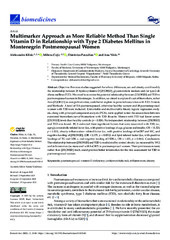Приказ основних података о документу
Multimarker Approach as More Reliable Method Than Single Vitamin D in Relationship with Type 2 Diabetes Mellitus in Montenegrin Postmenopausal Women
| dc.creator | Klisić, Aleksandra | |
| dc.creator | Cojić, Milena | |
| dc.creator | Patoulias, Dimitrios | |
| dc.creator | Ninić, Ana | |
| dc.date.accessioned | 2023-11-14T14:21:38Z | |
| dc.date.available | 2023-11-14T14:21:38Z | |
| dc.date.issued | 2023 | |
| dc.identifier.issn | 2227-9059 | |
| dc.identifier.uri | https://farfar.pharmacy.bg.ac.rs/handle/123456789/5228 | |
| dc.description.abstract | Objective: Previous studies suggested that ethnic differences, sex and obesity could modify the relationship between 25-hydroxyvitamin D [25(OH)D], glycometabolic markers and/or type 2 di- abetes mellitus (T2D). We aimed to examine the potential relationship between [25(OH)D] and T2D in postmenopausal women in Montenegro. In addition, we aimed to explore if a set of biomarkers, rather than [25(OH)D] as a single biomarker, could better explain its potential association with T2D. Patients and Methods: A total of 116 postmenopausal, otherwise healthy women and 48 postmenopausal women with T2D were included. Univariable and multivariable binary logistic regression analy- sis, along with principal component analysis (PCA), were applied to test the associations between examined biomarkers/set of biomarkers with T2D. Results: Women with T2D had lower serum [25(OH)D] levels than healthy controls (p = 0.024). No independent relationship between [25(OH)D] and T2D was found. PCA extracted three significant factors that were associated with T2D, i.e., age-glycometabolic-related factor (i.e., with positive loadings of age, glucose and insulin; OR = 11.321, p < 0.001), obesity-inflammation- related factor (i.e., with positive loadings of hsCRP and WC, and negative loading of [25(OH)D]; (OR = 2.079, p < 0.001)) and lipid-related factor (i.e., with positive loadings of TG and LDL-c, and negative loading of HDL-c; OR = 1.423, p = 0.044). Conclusions: The relationship between [25(OH)D] and T2D is modulated by central obesity (as measured by WC) and inflammation (as measured with hsCRP) in postmenopausal women. Their joint measurement, rather than [25(OH)D] itself, could provide better information for the risk assessment for T2D in postmenopausal women. | |
| dc.publisher | MDPI | |
| dc.relation | info:eu-repo/grantAgreement/MESTD/inst-2020/200161/RS// | |
| dc.rights | openAccess | |
| dc.rights.uri | https://creativecommons.org/licenses/by/4.0/ | |
| dc.source | Biomedicines | |
| dc.subject | inflammation | |
| dc.subject | obesity | |
| dc.subject | vitamin D deficiency | |
| dc.subject | cardiometabolic risk | |
| dc.subject | postmenopausal | |
| dc.title | Multimarker Approach as More Reliable Method Than Single Vitamin D in Relationship with Type 2 Diabetes Mellitus in Montenegrin Postmenopausal Women | |
| dc.type | article | |
| dc.rights.license | BY | |
| dc.citation.volume | 11 | |
| dc.citation.issue | 10 | |
| dc.citation.rank | M21~ | |
| dc.identifier.doi | 10.3390/biomedicines11102610 | |
| dc.identifier.pmid | 37892984 | |
| dc.identifier.scopus | 2-s2.0-85175423140 | |
| dc.identifier.fulltext | http://farfar.pharmacy.bg.ac.rs/bitstream/id/14542/Multimarker_Approach_as_pub_2023.pdf | |
| dc.type.version | publishedVersion |

